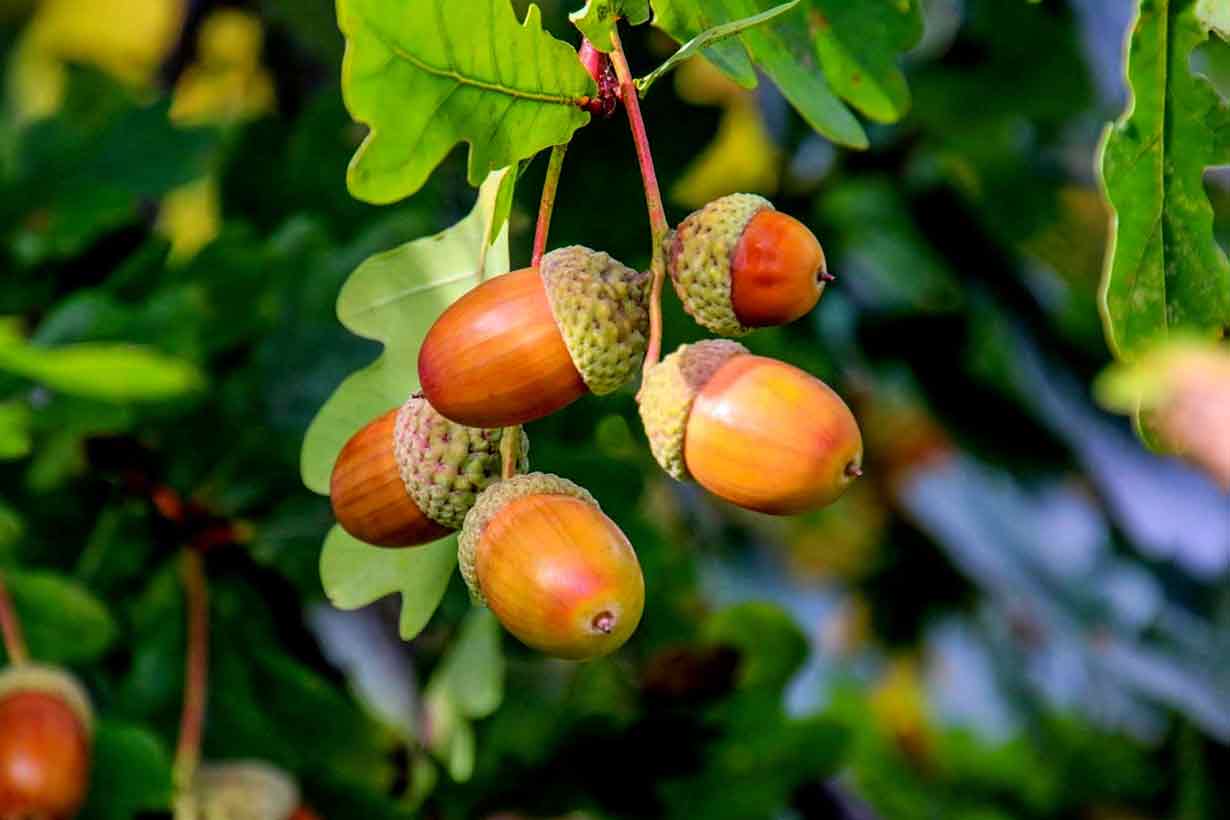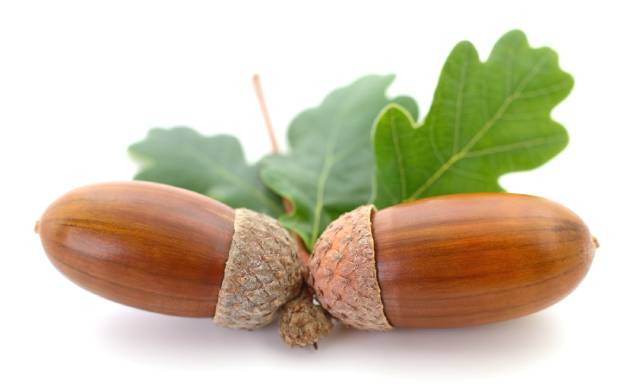Acorns grow in most parts of the world, but most of us don’t think of them as food.
Interestingly, acorns are edible, providing that they are correctly prepared.
This article provides a guide to edible acorns, their nutritional values, and their potential benefits and drawbacks.
What are acorns?
Firstly, acorns are a species of nut. Acorns are the nuts of the oak tree, and they contain two seeds inside their hard outer shell.
In a similar way to other popular nuts, acorns provide carbohydrate, fat, protein, and a wide range of essential nutrients.
However, unlike other nuts, acorns contain substantial concentrations of tannic acid (tannins).
Tannins are a type of water-soluble polyphenol that is also found in tea and wine, and they have a bitter taste. These compounds may have both positive and negative impacts on human health (1, 2).
One negative point is that tannins can act as an antinutrient, and studies suggest that they may inhibit the absorption of dietary iron. A large intake of tannins will also have an unpleasant taste, and excessive doses may potentially be harmful to the liver (1, 3, 4).
For this reason, acorns require appropriate preparation (such as leaching) before being consumed. Providing they have been adequately prepared to remove excess tannins, acorns have a mild nutty flavor.
While acorns were part of traditional human diets, they are not a significant part of modern diets.
Preparation
Acorns are not suitable to eat in their raw and unprepared state, so the first stage involves leaching.
However, before leaching the acorns, it is important to choose the right ones.
On this note, there are several different varieties of acorns. While all acorns contain large amounts of tannins, the bitter types of the nut contain substantially higher concentrations, and they require longer leaching processes.
Choosing the right acorns
White oak acorns take the least time to mature and have the lowest tannin content among different acorns. Therefore, they require the least leaching time and have a less bitter taste.
Research in this area has demonstrated that white oak acorns contain much lower concentrations of tannins than other acorn varieties (5).
For reference, the following image shows what a white oak acorn looks like:
Other varieties of acorns, such as red oak acorns, are still edible, but they require longer leaching times to remove the more considerable amount of tannins.
Shelling and leaching
Remember how tannins are water-soluble polyphenols?
Since these compounds are water-soluble, it means that we can easily remove them by soaking the acorns in water, which is known as ‘leaching’ (6).
There are two different ways to leach acorns, and these include either a long soaking period or boiling them for an extended time, which has a quicker effect. Before leaching the acorns, though, they need to be deshelled.
For those who need help with how to shell and leach acorns, this helpful guide explains the process in a simple manner.
How to eat acorns
There are several ways in which we can use acorns. Three of the most popular methods include:
- Roasted acorns
- Acorn flour
- Acorn jelly
Roasted acorns
Roasting acorns simply involves putting the acorns on an oven tray, adding any desired seasonings, and then roasting them for fifteen minutes at 177°C (350°F). Wikihow has an illustrated step-by-step guide that explains the roasting process clearly.
For seasoning, simple additions like salt and garlic powder work well.
Once roasted, the acorns can be eaten alone or combined with other nuts and seeds.
Acorn flour
After roasting acorns, it is also possible to turn them into flour for baking.
This process is straightforward and simply involves putting them into a blender or food processor for about 20 seconds. As an alternative, a generic hand grinder will also work well.
Acorn jelly (dotori-muk)
Dotori-muk, which translates as ‘acorn jelly,’ is a popular Korean side dish made from acorn flour.
Making acorn jelly is simple and involves mixing acorn flour with cold water, oil, and salt, and then heating it while stirring in a pan.
After this, the mixture should be spooned into a container and then refrigerated until it forms a firm jelly-like texture.
Acorn jelly is an acquired taste due to its unique flavor and appearance, but it tastes good in combination with a soy sauce-based condiment.
There is a good recipe for the jelly and a Korean spicy companion sauce available here.
Acorns are a good source of nutrients
Using data sourced from the USDA FoodData Central database, the basic nutritional values for acorns are shown in the table below (7):
| Calories/nutrient | Amount | % Daily value |
|---|---|---|
| Calories | 110 kcal | |
| Carbohydrate | 11.55 g | 3.9% |
| Fat | 6.76 g | 10.4% |
| Saturated | 0.88 g | 4.4% |
| Monounsaturated | 4.28 g | |
| Polyunsaturated | 1.30 g | |
| Protein | 1.74 g | 3.5% |
As shown in the table, acorns contain moderately high amounts of carbohydrates and dietary fat.
The majority of their fat content comes from monounsaturated fat. Acorns are low in both saturated and polyunsaturated fats.
Vitamins and minerals
While acorns aren’t quite as nutrient-rich as nuts like Brazil nuts, they do still offer a good range of nutrients.
Per ounce (28g) serving, acorns provide the following vitamins and minerals:
- Copper: 20% DV
- Manganese: 17% DV
- Vitamin B6: 9% DV
- Folate: 6% DV
- Magnesium: 4% DV
- Pantothenic acid (B5): 4% DV
- Potassium: 3% DV
- Niacin (B3): 3% DV
- Phosphorus: 2% DV
- Thiamin (B1): 3% DV
- Riboflavin (B2): 2% DV
- Calcium: 1% DV
- Iron: 1% DV
- Zinc: 1% DV
These daily values are calculated by combining the USDA nutritional data with the current % daily values for nutrients published by the FDA (7, 8).
Do acorns have any benefits?
Firstly, there is no current human research on acorns, so any bold claims of benefits should be taken with a pinch of salt.
However, as noted earlier in this article, acorns are a significant source of tannins, which are a type of polyphenol.
The nuts are also an excellent source of monounsaturated fatty acids.
Polyphenol content
As previously discussed, the significant concentration of tannins in acorns may cause some unwanted side effects if the acorns are not correctly soaked.
That said, tannins may also have some positive effects.
After all, tannins are the same class of polyphenols that appear in several foods and drinks, and they are particularly concentrated in tea and red wine (9).
The Journal of Food Engineering published a paper presenting the results of a chemical investigation into acorn samples. This particular research showed that the main tannins in polyphenols are gallic acid groups (10).
Gallic acid is thought to have beneficial effects on human health, but unfortunately, there are no human clinical trials to confirm at this point (11).
However, mechanistic, cellular, and animal studies suggest that gallic acid may potentially have benefits for cardiovascular, gastrointestinal, and metabolic health (12).
Monounsaturated fat
The primary fatty acid in acorns is oleic acid, which is a type of monounsaturated fat.
In this regard, a physical and chemical evaluation of acorns showed that oleic acid represents 63% of the total fat content (10).
In a recent systematic review of 28 clinical trials, diets high in oleic acid were positively associated with weight loss, particularly regarding abdominal fat (13).
Further research suggests that monounsaturated fat may have a beneficial effect on insulin sensitivity and cardiovascular health. However, the science on the latter point is mixed; while some studies suggest an association between monounsaturated fat and a reduction in cardiovascular risk, others do not (14).
Are there any concerns about acorns?
Aside from their excessive levels of tannic acid in their unprepared state, there are a couple more issues to be aware of.
Allergy
Tree nuts such as almonds, chestnuts, and hazelnuts are among the most highly allergenic foods, and acorns are technically a form of tree nut (15).
The Food Allergy Resource and Research program at the University of Nebraska-Lincoln notes that approximately 1.1% of the population has a tree nut allergy. Furthermore, the nuts are responsible for 33% of allergy-related deaths in the United States (16).
However, it is worth noting that some tree nuts—such as almonds, cashews, hazelnuts, and walnuts—are a more common cause of allergic reaction than acorns (17).
That said, there are known cases of allergic reactions to acorns, and there are several published case studies on the issue (18, 19).
Anyone with an existing nut allergy may wish to speak to their doctor before trying acorns.
Final Thoughts
There is nothing unique about acorns nutritionally, and the nutrients they provide can be easily obtained from elsewhere.
However, acorns do have interesting taste characteristics, they provide a good range of nutrients, and they can be used to make several tasty recipes.
For those who enjoy foraging, it is possible to collect a large number of them in the autumn season. In contrast, products like acorn flour are available to buy in their ready-made state.
Related Articles
14 Types of Nuts: How Do They Compare?


